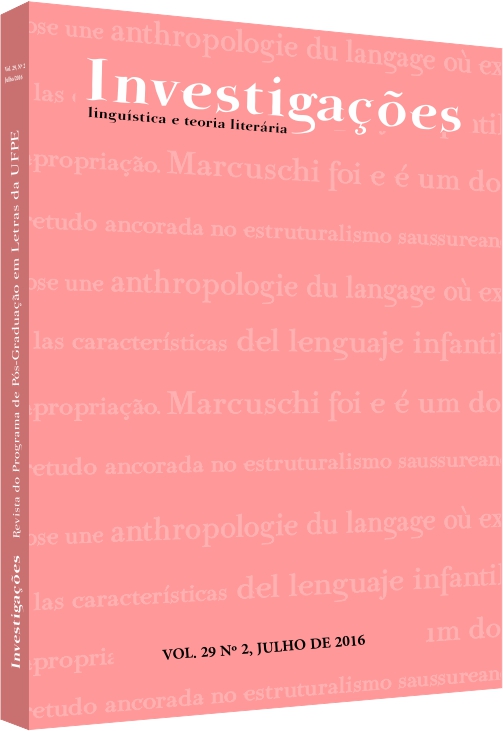A contribuição dos gestos para a comunicação entre professor e aprendizes nas interações em inglês (L2)
Abstract
Este estudo tenciona mapear o uso de gestos por parte de um professor de inglês durante uma atividade no contexto de uma escola de idiomas da cidade de Campina Grande – PB. A análise focalizará uma atividade de produção oral conduzida no início de uma aula dada numa turma de inglês como L2 de nível intermediário, a qual foi registrada em audiovisual através de uma filmadora digital portátil. Os resultados obtidos aqui indicam que, além de evidenciarem aspectos dos processos mentais internos do participante investigado, os gestos contribuem para a comunicação entre professor e aprendizes nas interações em inglês.References
ALLWRIGHT, D.; BAILEY, K. M. Focus on the Language Classroom: An Introduction to Classroom Research for Language Teachers. Cambridge: Cambridge University Press, 1991.
BAKHTIN, M. (VOLOCHINOV). Marxismo e Filosofia da Linguagem. 7 ed. São Paulo: Hucitec, 1997 [1929].
BAVELAS, J.; HEALING, S. Reconciling the effects of mutual visibility on gesturing: A review. Gesture, 13(1), 2013. p. 63–92.
BEZERRA, J. T. G. M. et al. Softwares de transcrição como auxílio para as pesquisas com enfoque multimodal no processo de aquisição da linguagem. Revista Texto Livre: Linguagem e Tecnologia, v. 9, n. 1, 2016. p. 77-93.
BRONCKART, J. P. Atividade de Linguagem, textos e discursos. Por um interacionismo sócio-discursivo. São Paulo: EDUC, 1999.
CHIAVEGATTO, V. C. Introdução à linguística cognitiva. Matraga, Rio de Janeiro, v. 16, n. 24, jan./jun. 2009.
DA FONTE, R. F. L. Fluência/Disfluência e Gesticulação: compreendendo a aquisição da linguagem de uma criança cega. Revista Intercâmbio, v. XXIX, 2014. p. 202-217.
DIONÍSIO, A. P. Análise da conversação. In: MUSSALIN, F.; BENTES, A. C. (orgs.). Introdução à linguística: domínios e fronteiras, v. 2. 5. ed. São Paulo: Cortez, 2006.
ELLIS, R. Learning a second language through interaction. Philadelphia, PA: John Benjamins, 1999.
ERLING, E. J. The many names of English: a discussion of the variety of labels given to the language in its worldwide role. English Today, Cambridge, v. 21, n. 1, 2005. p. 40-44.
FONTE, R. et al. A matriz gesto-fala na aquisição da linguagem: algumas reflexões. In: BARROS, I. R. et al. (Org.). Aquisição, desvios e práticas de linguagem. 1. ed. Curitiba: CRV, 2014. p. 11-26.
GOLDIN-MEADOW, S. The role of gesture in communication and thinking. Trends in Cognitive Sciences, 3(11), 1999. p. 419-429.
GOLDIN-MEADOW, S.; ALIBALI, M. Gesture’s role in speaking, learning, and creating language. Annual Review of Psychology, vol. 64, 2013. p. 257-283.
KENDON, A. The Study of Gesture: some remarks on its history. Recherches sémiotiques/semiotic inquiry, v. 2, 1982. p. 45-62.
______. Language and Gesture: Unity or Duality? In: MCNEILL, D. (Ed.). Language and Gesture. Cambridge University Press: Cambridge, UK, 2000. p. 47-63.
______. Gesture: Visible Action as Utterance. Cambridge: Cambridge University Press, 2004.
______. Language’s matrix. Gesture, v. 9, n. 3, 2009. p. 355–372.
LOEHR, D. P. Gesture and Intonation. Ph.D. dissertation. Washington, DC: Georgetown University, 2004.
MACNEILAGE, P. F. The Origin of Speech. Oxford: Oxford University Press, 2008.
MCNEILL, D. Hand and mind: what gestures reveal about thought. Chicago, IL: University of Chicago Press, 1992. p. 75-104.
______. Introduction. In: MCNEILL, D. (ed.) Language and Gesture. Cambridge University Press, 2000.
______. Gesture. In: HOGAN, P. C. (Ed.). Cambridge encyclopedia of the language sciences. Cambridge, England: Cambridge University Press, 2005. p. 344-346.
______. Gesture: a psycholinguistic approach. In: BROWN, E.; ANDERSON, A. (eds.) The Encyclopedia of Language and Linguistics. Amsterdam/Boston: Elsevier, 2006. p. 58-66.
MORI, C. O desenvolvimento gestual de uma criança ouvinte e outra deficiente auditiva: um estudo contrastivo. Dissertação de Mestrado Não-Publicada, Programa de Pós-Graduação em Linguística, Unicamp, Campinas, 1994.
PEREIRA, M. C. Interação e construção do sistema gestual em crianças deficientes auditivas filhas de pais ouvintes. Tese de Doutorado Não-Publicada, Programa de Pós-Graduação em Linguística, Unicamp, Campinas, 1989.
SANTANA, A. P. et al. O estatuto simbólico dos gestos no contexto da surdez. Psicologia em Estudo. Maringá, v. 13, n. 2, 2008. p. 297-306.
STERN, H. H. Fundamental Concepts of Language Teaching. Oxford: Oxford University Press, 1991.
TOMASELLO, M. Origins of Human Communication. Cambridge, MA; London: MIT Press, 2008.
XU, G. Understanding the role of interaction from linguistic, affective, and social perspectives. TESL Canada Journal, 27, 2010. p. 68-88.
Downloads
Published
How to Cite
Issue
Section
License
Copyright (c) 2016 Felipe Santos dos Reis

This work is licensed under a Creative Commons Attribution 4.0 International License.
Authors who publish with Revista Investigações agree to the following terms:
Authors retain copyright and grant the journal right of first publication with the work simultaneously licensed under the Creative Commons Attribution 4.0 International (CC BY 4.0) license that allows others to share the work with an acknowledgement of the work's authorship and initial publication in this journal.
Authors are able to enter into separate, additional contractual arrangements for the non-exclusive distribution of the journal's published version of the work (e.g., post it to an institutional repository or publish it in a book), with an acknowledgement of its initial publication in this journal.
You are free to:
Share — copy and redistribute the material in any medium or format for any purpose, even commercially.
Adapt — remix, transform, and build upon the material for any purpose, even commercially.
The licensor cannot revoke these freedoms as long as you follow the license terms.
Under the following terms:
Attribution — You must give appropriate credit , provide a link to the license, and indicate if changes were made . You may do so in any reasonable manner, but not in any way that suggests the licensor endorses you or your use.
No additional restrictions — You may not apply legal terms or technological measures that legally restrict others from doing anything the license permits.

